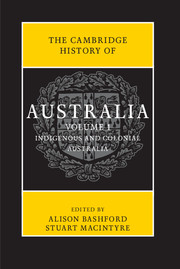Book contents
- Frontmatter
- Contents
- Abbreviations
- List of maps
- List of figures
- List of tables
- Notes on contributors
- Map
- Preface
- Introduction
- PART I
- PART II
- Further reading
- Chronology
- Index
- Frontmatter
- Contents
- Abbreviations
- List of maps
- List of figures
- List of tables
- Notes on contributors
- Map
- Preface
- Introduction
- PART I
- PART II
- 9 Religion
- 10 Culture and media
- 11 Science and medicine
- 12 Society and welfare
- 13 Gender and sexuality
- 14 Indigenous Australia
- 15 Class
- 16 The economy
- 17 Government, law and citizenship
- 18 Education
- 19 The environment
- 20 Travel and connections
- 21 Security
- 22 Australia, Britain and the British Commonwealth
- 23 Australia in the Asia-Pacfic region
- 24 The history anxiety
- Further reading
- Chronology
- Index
10 - Culture and media
from PART II
Published online by Cambridge University Press: 05 November 2013
- Frontmatter
- Contents
- Abbreviations
- List of maps
- List of figures
- List of tables
- Notes on contributors
- Map
- Preface
- Introduction
- PART I
- PART II
- Further reading
- Chronology
- Index
- Frontmatter
- Contents
- Abbreviations
- List of maps
- List of figures
- List of tables
- Notes on contributors
- Map
- Preface
- Introduction
- PART I
- PART II
- 9 Religion
- 10 Culture and media
- 11 Science and medicine
- 12 Society and welfare
- 13 Gender and sexuality
- 14 Indigenous Australia
- 15 Class
- 16 The economy
- 17 Government, law and citizenship
- 18 Education
- 19 The environment
- 20 Travel and connections
- 21 Security
- 22 Australia, Britain and the British Commonwealth
- 23 Australia in the Asia-Pacfic region
- 24 The history anxiety
- Further reading
- Chronology
- Index
Summary
The dynamics shaping culture and media in Australia across the twentieth century emerged in a context defined by both urban concentration and widely dispersed regions: tensions between localism and national integration of production and markets; persistent calls for a national culture or cultural industries; domination by a few large national or multinational operators; and intervention by public institutions in the commercial marketplace. Underpinning all are the complexities of Australia's place in transnational cultural networks. The domestic market was not large enough to sustain major production industries but it was sufficiently large to be a target for cultural exports such as Hollywood movies and British books. In the early twentieth century, as in the early twenty-first, Australian culture was inevitably a hybridisation of local and external influences, prompting recurrent debates over national values, modernity and ‘Americanisation’. Modernity and nationhood had arrived together, generating anxieties that the nation was both too modern, with no deep traditions of its own, and not modern enough, always lagging behind the great metropolitan centres. Yet even as the ‘true Australia’ was located in the image of a pre-modern bush landscape, Australians were busily engaging with the new modern cultures. The British imperial connection was not merely a conservative force but a means of accessing the new.
Modernity at home
In April 1922 the Sydney Triad announced its latest issue as ‘a Mary Pickford number’. The Hollywood star featured on the magazine's cover and in an adoring article. In a published letter to the editors, Pickford claimed she never missed an issue. This episode could be taken as evidence of the lack of a vigorous, independent Australian culture in the decades after Federation. For the pioneering cultural historian Geoffrey Serle, the 1920s were ‘a scurvy period, when Australians seemed content to accept second-rateness’. Following the ‘nationalist surge’ of the 1880s and 1890s, the early twentieth century was marked by ‘a perpetuation of colonial dependence and a curious hesitation in development towards nationhood’.
- Type
- Chapter
- Information
- The Cambridge History of Australia , pp. 237 - 262Publisher: Cambridge University PressPrint publication year: 2013
- 2
- Cited by



